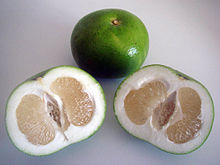- Oroblanco
-
Oroblanco 
Details Hybrid parentage Citrus grandis × C. Paradisi/Citrus maxima/Citrus grandis Cultivar Oroblanco Origin University of California, Riverside An oroblanco or sweetie (Citrus grandis Osbeck × C. Paradisi Macf.) is a cross between an acidless pomelo and a white grapefruit. It is slightly larger in size than a grapefruit but has fewer seeds and is sweeter. When ripe, its thick rind is bright green or golden in color. The Oroblanco fruit has a similar taste to the scent of its flowers. The tree does not grow in cold conditions, but it has a tendency to adapt to its environment very fast and is a vigorous grower.
The oroblanco was patented by the University of California after its development at that university's citrus experiment station in Riverside, California.[1]
Oroblancos are round (or sometimes slightly flattened), with a thicker rind than grapefruit. When eaten, an oroblanco lacks bitterness associated with grapefruits and is rather sweet, but the white membranes separating the fleshy segments are bitter and usually discarded. Oroblancos are available from September through December. Their sweetness attracts many buyers in many countries, for example Japan and Finland, where the fruit is commonly referred to as a "sweetie."
The oroblanco tree comes in quickly and vigorously adapts to its environment. It is estimated that Oroblanco is grown on 1,500 ha (3,707 acres) in California, and over 10 ha (25 acres) in Australia. A similar fruit is also commonly cultivated in Israel (since 1984), where the trademark "Sweetie" originated.[2][3]
Oroblancos may be peeled and eaten like an orange, by tearing into segments, and are often eaten as a breakfast food. As a newly engineered fruit it remains a relatively expensive product.
Notes
- ^ US Patent and Trademark Office http://patft.uspto.gov/netacgi/nph-Parser?Sect2=PTO1&Sect2=HITOFF&p=1&u=/netahtml/PTO/search-bool.html&r=1&f=G&l=50&d=PALL&RefSrch=yes&Query=PN/PP4645 accessed 13 November 2010.
- ^ Citrus Marketing Board of Israel http://www.jaffa.co.il/category.asp?id=61 accessed 13 November 2010.
- ^ Citrus Pages http://users.kymp.net/citruspages/jaffacitrus.html#sweetie accessed 13 November 2010

This Rutaceae article is a stub. You can help Wikipedia by expanding it.
